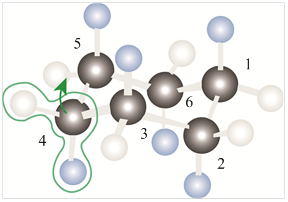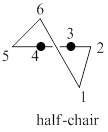
Concept explainers
Interpretation:
A model of chair cyclohexane corresponding to the leftmost model in the given figure is to be drawn. The two reasons corresponding to the fact that the half-chair conformation is less stable than the chair or twist-boat conformation is to be stated.
Concept introduction:
The conformation of cyclohexane is a type of
Answer to Problem 7.1P
A model of chair cyclohexane corresponding to the leftmost model in the given figure is shown below.

The half-chair conformation is less stable than the chair or twist-boat conformation because half-chair conformation has maximum ring strain and the presence of angle strain in half-chair conformation of cyclohexane molecule.
Explanation of Solution
The given leftmost figure of chair conformation of cyclohexane is shown as,

Figure 1
The model of chair conformation of cyclohexane corresponding to the leftmost model is shown as,

Figure 2
If the carbon-4 in order to locate carbons 2-5 in a common plane then the above model chair conformation of cyclohexane is shown as,

Figure 3
Thus, the raising of carbon-4 in order to locate carbons 2-5 in a common plane forms the half-chair conformation of cyclohexane molecule. This half-chair conformation of cyclohexane molecule is a transition state for the conversion into the chair and twist boat conformations.
The two reasons which explain that the half-chair conformation is less stable than the chair or twist-boat conformation are as follows.
• The ring strain in half chair conformation is more as compared to the chair or twist-boat conformation.
• The angle strain of
A model of chair cyclohexane corresponding to the leftmost model in the given figure has been shown above. The two reasons corresponding to the fact that the half-chair conformation is less stable than the chair or twist-boat conformations has been stated above.
Want to see more full solutions like this?
Chapter 7 Solutions
EBK ORGANIC CHEMISTRY
- I have a 2 mil plastic film that degrades in 22 days at 88C and 153 days at 61C what is the predicted theoretical degradation at 47C?arrow_forwardno ai walkthrougharrow_forwardI have a 2 mil plastic film that degrades after 22 days at 88C and at 61C takes 153 days. What is the failure at 47C in days.arrow_forward
- If a 5 film plastic film degraded in 30 days at 35C and the same film degraded in 10 days at 55 C and 2 days at 65C what would the predicted life time be at 22C for the same film?arrow_forwardno Ai walkthroughsarrow_forwardI have a aqueous solution (175 ml) of iridium trichloride containing 8,750 ppm Iridium by ICP OES analysis. What is the percent concentration of Iridium trichloride in aquous solution and provide the concentration in moles per liter, percentage by weight.arrow_forward
- no Ai walkthroughsarrow_forward136 PRACTICAL SPECTROSCOPY Compound 78 is a high-boiling liquid (boiling point 189° C) that contains halogen, but will not react with alkoxides to yield an halogen. ether. The Mass, IR, and 'H NMR spectra, along with 13C NMR data, are given below. Elemental Analysis: C, 35.32; H, 2.47; contains BC Spectral Data: doublet, 137.4 ppm; doublet, 130.1 ppm; doublet, 127.4 ppm; singlet, 97.3 ppm Absorbance Mass Spectrum Intensity 77 77 204 M + 128 40 60 80 100 120 140 160 180 m/e 200 220 280 240 260 300 Infrared Spectrum Wave Number, cm -1 4000 3000 2500 2000 1500 1300 1200 1100 1000 900 800 700 3 6 7 8 9 10 12 13 15 Wavelength, microns 'H NMR wwwww 5 Structure: www ppm, & ©2000 Brooks/Cole Publishing Com-arrow_forwardno Ai walkthroughsarrow_forward
 Organic Chemistry: A Guided InquiryChemistryISBN:9780618974122Author:Andrei StraumanisPublisher:Cengage Learning
Organic Chemistry: A Guided InquiryChemistryISBN:9780618974122Author:Andrei StraumanisPublisher:Cengage Learning
